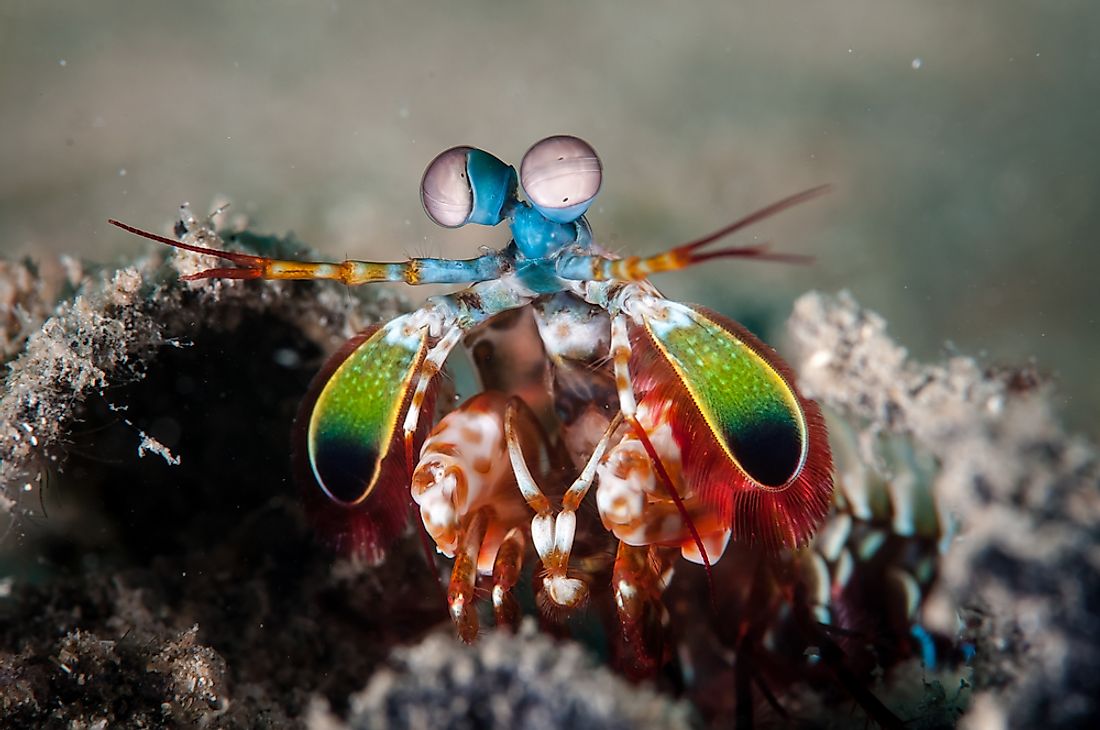Mantis Shrimp Facts - Animals of the Oceans

The mantis shrimp is the name given to marine crustaceans of the “Stomatopoda” order. The origin of these crustaceans goes back 400 million years making them among the planet’s most ancient animals. The ancient Assyrians called the mantis shrimp the “sea locust” while its name in modern-day Australia is the “prawn killer.” The mantis shrimp is a delicacy in many countries around the world and are prepared by boiling, frying, or grilling.
Physical Description
Adult mantis shrimps usually grow to 3.9 inches in length, but some have been observed to reach about 15 inches in length. One specimen caught in the United States was 18 inches in length and holds the record for the world’s largest mantis shrimp. The carapace of mantis shrimp covers only its head and upper thorax. The mantis shrimp’s eyes are straddled on two mobile stalks allowing the eyes to move independently. The eyes of the crustacean are among the most intricate eyes of any animal, with the shrimp having the ability to discern multispectral images and polarized light. Different species of mantis shrimp have different body coloration, and some, such as the peacock shrimp, have elaborately colored bodies.
Behavior
The mantis shrimp spends many hours hiding in burrows or rock formations on the seabed. The time of day when the mantis shrimp is most active depends on the species. A ferocious predator, the mantis shrimp, is a nightmare for many small animals in its habitats. The mantis shrimp’s behavior of actively chasing and killing prey is uncharacteristic of the crustaceans. Some shrimp species have front appendages that have evolved to form club-like structures that the crustaceans use to kill their prey by hammering or punching. The appendages also come in handy in violent confrontations between individuals for mates and territory. Scientists have found that among t Shrimp Mantis can throw the most powerful and the fastest punch in nature. They strike with a force of a gun bullet shattering shells and even aquarium glasses. As the limbs unfurl they accelerate at 10,000 times greater than the gravity and the top speed reaches 50 miles per hour, these fetes are staggering given the resistance of water. Such achievements make the mantis shrimp the animal with the fastest limbs movement in the world. The punch reaches its target in under 3,000th of a second.
Habitat And Range
The crustacean is predominantly found in sub-tropical and tropical marine habitats. However, some species are also found in temperate marine habitats. Marine shrimps inhabit the waters of the Pacific and Indian Oceans, with large concentrations being found in the East African coast and Hawaii.
Diet
Mantis shrimps with the club-like appendages are known as smashers while spearers are shrimps whose front appendages are modeled into spiny barbs. The two types of shrimps have a different choice of prey items where smashers have a preference for shelled invertebrates such as snails, mollusks, and crabs since their powerful clubs can shatter the protective shells of their prey. Spearers, on the other hand, prefer soft prey such as fish, with their spear-like appendages being best suited to slice flesh.
Reproduction
Mantis shrimps are recognized as monogamous species, with a breeding pair being together for as much as 20 years. In most shrimp species, the female lays its eggs in a burrow, but some species have females carrying the eggs until they hatch.In some species, the female nurtures the eggs while the male’s responsibility is feeding the female. However, the common behavior observed in most shrimp species is biparental care where both parents take turns in taking care of the eggs. The female of the Pullosquilla shrimp species lays two sets of eggs and takes care of one clutch while the male takes care of the other.











